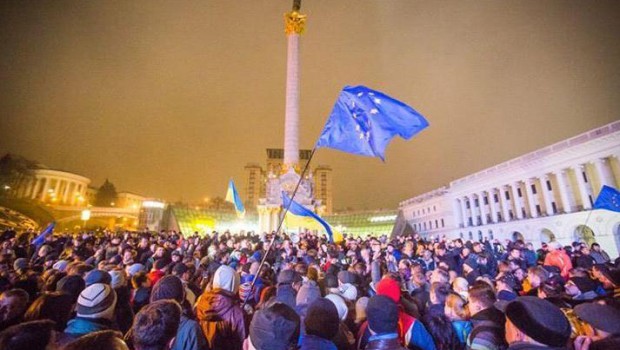
Ukraine, the Euromaidan and the EU—A Net Assessment of Kyiv’s Course Toward Europe Since the Start of 2014
Publication: Eurasia Daily Monitor Volume: 11 Issue: 185
By:

Western powers lost control and, to some extent, lost comprehension of the situation in Ukraine during the Euromaidan mass protest movement and its aftermath. They then trailed behind the events throughout Russia’s war against Ukraine to date. The European Commission’s lame-duck status during most of 2014, Germany’s attempts to fill the European Union’s leadership vacuum, and the advent of a new Commission in October 2014, have compounded the policy confusion and drift.
Brussels had not anticipated Russia’s economic countermeasures that compelled Viktor Yanukovych’s government to backtrack on the association agreement with the EU. When that occurred, Brussels proved unwilling and basically unable to offset the impact of those Russian measures on Ukraine. The EU took the position that Kyiv’s decision was a mistaken one, not in Ukraine’s best interest, but that the president and government had been legitimately elected and were constitutionally empowered to take that decision. The EU intended to continue negotiations with Ukraine’s incumbent president and government, hoping to sign the association agreement with Yanukovych at the EU-Ukraine summit due in April 2014.
The United States initially followed the EU’s lead on Ukraine. At one point, US Assistant Secretary of State Victoria Nuland held out the appeal of a “Europe from the Atlantic to Donetsk” (Testimony of Assistant Secretary of State Victoria Nuland before the Senate Foreign Relations Committee, November 14, 2013). That was a rare example of strategic insight amid the unedifying Western debates. That definition of Europe embraced Ukraine in its entirety while excluding Russia, contrary to the “Europe from the Atlantic to Vladivostok” slogan that would marginalize the US while placing Europe, as well as Ukraine, in Russia’s shadow. Donetsk was, of course, the epicenter of Ukraine’s then-ruling authorities. But “Donetsk” failed to grasp the cooptation offer from Brussels or Washington.
Attending the EU’s summit in Vilnius in late November 2013 as guests, Ukrainian opposition leaders Arseniy Yatsenyuk, Vitali Klitschko, and Oleh Tiahnybok announced on the spot that they would launch a regime change campaign in Ukraine through extra-parliamentary methods. That campaign soon materialized on the Maidan, contradicting the EU’s policy at that stage (see EDM, December 3, 2013).
As the Maidan (soon rechristened the “Euromaidan”) grew in organized strength and numbers, and fighting with the police intensified in January–February 2014, Western governments and media reverted to the template of the 2004–2005 Orange Revolution in Ukraine. For all its subsequent failures, the 2004–2005 regime change had earned a title to legitimacy based on its peaceful character and not provoking the forces of order to intervene. By contrast, the Euromaidan deployed some violent groups of the radical right, equipped for combat and challenging the police. While the majority of Maidan demonstrators did not participate in violent actions, it was the combatant minority that determined the ultimate outcome through violence. Some political leaders abroad, and many influential commentators, treated this process mainly in terms of revolutionary expediency.
Equating the Kyiv Maidan with “the people of Ukraine” meant ignoring the views and moods of large parts of Ukraine’s east. Insisting that the Maidan’s tactics had been peaceful and legitimate emboldened anti-Maidan (or anti-Western, or simply benighted) groups in Ukraine’s east to use mirror tactics against Ukrainian authorities during the initial stages of the secessionist movement. Defending the Ukrainian people’s (instead of the state’s) right of self-determination on the European choice made it easier for the secessionists (and Russia behind them) to claim self-determination for their own Russian choice.
Even before the end-game, Maidan’s political leaders had lost the ability to control the combat groups. The European Union, key European governments, and Washington had also lost their capacity to influence the end game in Kyiv. They were no longer acting in unison. Washington seemed to favor a change of government under opposition politicians Arseniy Yatsenyuk and Vitaliy Klitschko. However, Germany favored a compromise with the Yanukovych government and, indirectly, with Russia.
On February 20–21, in Kyiv, foreign affairs ministers Frank-Walter Steinmeier of Germany, Laurent Fabius of France and Radoslaw Sikorski of Poland brokered a compromise agreement between Yanukovych and the Maidan’s three political leaders. The Kremlin’s “human rights” envoy, Vladimir Lukin, witnessed the signing on President Vladimir Putin’s behalf, implying consent to the agreement. The Kremlin wanted to participate in the implementation process. The agreement’s salient provisions were: formation of a “coalition government of national unity” within 12 days (while the Party of Regions was the strongest by far in Parliament, pending parliamentary elections in 2017); a presidential election to be held by December 2014 (merely abridging Yanukovych’s tenure by three or four months, and not ruling out his repeat candidacy); joint investigation by all sides into the acts of violence; the opposition to unblock public spaces and hand over its weapons to the police (auswaertiges-amt.de, February 21).
In the event, the combatant Maidan overruled its presumptive political leaders who had signed that agreement; and the Maidan’s ultimatum resulted in toppling the president and government on February 22, for a conclusive regime change. This solution had the triple merit of: clearing the path for the new government to pursue the European association agenda, untrammeled by ambiguous or unreliable coalition partners; shifting Kyiv’s overall orientation toward the West, after two decades of Ukraine’s “dual-vector” balance between Russia and the West; and henceforth, denying Russia the role of stakeholder in Ukraine’s political development.
Ukraine achieved the necessary clean break with Russia. The European Union and Ukraine signed the association agreement on March 21 (political agreement) and on June 27 (free trade agreement). President Petro Poroshenko described the signing as the most important since Ukraine’s 1991 achievement of state independence (Ukrinform, June 27–28, 2014). However, Russia initiated a war against Ukraine attempting to reverse that clean break; while the EU, under a new Commission and driven in part by Germany, seems uncertain about how to handle Ukraine at this stage.




